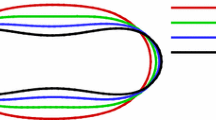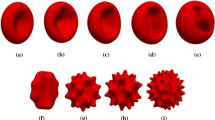Abstract
In this paper, a novel 3D numerical method has been developed to simulate red blood cells (RBCs) based on the interaction between a shell-like solid structure and a fluid. RBC is assumed to be a thin shell encapsulating an internal fluid (cytoplasm) which is submerged in an external fluid (blood plasma). The approach is entirely based on the smoothed particle hydrodynamics (SPH) method for both fluid and the shell structure. Both cytoplasm and plasma are taken to be incompressible Newtonian fluid. As the kinematic assumptions for the shell, Reissner–Mindlin theory has been introduced into the formulation. Adopting a total Lagrangian (TL) formulation for the shell in the realm of small strains and finite deflection, the presented computational tool is capable of handling large displacements and rotations. As an application, the deformation of a single RBC while passing a stenosed capillary has been modeled. If the rheological behavior of the RBC changes, for example, due to some infection, it is reflected in its deformability when it passes through the microvessels. It can severely affect its proper function which is providing the oxygen and nutrient to the living cells. Hence, such numerical tools are useful in understanding and predicting the mechanical behavior of RBCs. Furthermore, the numerical simulation of stretching an RBC in the optical tweezers system is presented and the results are verified. To the best of authors’ knowledge, a computational tool purely based on the SPH method in the framework of shell–fluid interaction for RBCs simulation is not available in the literature.












Similar content being viewed by others
References
Adami S, Hu XY, Adams NA (2012) A generalized wall boundary condition for smoothed particle hydrodynamics. J Comput Phys 231:7057–7075
Antoci C, Gallati M, Sibilla S (2007) Numerical simulation of fluidstructure interaction by SPH. Comput Struct 85:879–890
Aristodemo F, Federico I, Veltri P, Panizzo A (2010) Two-phase SPH modeling of advective diffusion processes. Environ Fluid Mech 10:451–470
Ay C, Lien CC, Wu MC (2014) Study on the Youngs modulus of red blood cells using atomic force microscope. Appl Mech Mater 627:197–201
Belytschko T, Guo Y, Kam Liu W, Ping Xiao S (2000) A unified stability analysis of meshless particle methods. Int J Numer Methods Eng 48:13591400
Belytschko T, Liu WK, Moran B, Elkhodary K (2014) Nonlinear finite elements for continua and structures, Second edn. Wiley, New York
Betsch P, Menzel A, Stein E (1998) On the parametrization of finite rotations in computational mechanics: A classification of concepts with application to smooth shells. Comput Methods Appl Mech Eng 155(3):273–305
Cleary PW, Monaghan JJ (1999) Conduction modeling using smoothed particle hydrodynamics. J Comput Phys 148:227–264
Cordasco D, Bagchi P (2013) Orbital drift of capsules and red blood cells in shear flow. Phys Fluids 25:091902
Dupire J, Socol M, Viallat A (2012) Full dynamics of a red blood cell in shear flow. PNAS 109(51):20808–20813
Fedosov D, Caswell B, Karniadakis G (2010) A multiscale red blood cell model with accurate mechanics, rheology, and dynamics. Biophys J 98(10):2215–25
Fedosov DA, Noguchi H, Gompper G (2014) Multiscale modeling of blood flow: from single cells to blood rheology. Biomech Model Mechanobiol. 13(2):239–58
Freund JB (2014) Numerical simulation of flowing blood cells. Annu Rev Fluid Mech 46:67–95
Gingold RA, Monaghan JJ (1977) Smoothed particle hydrodynamics: theory and application to non-spherical stars. Mon Notices R Astron Soc 181:375
Gomez-Gesteira M, Rogers BD, Dalrymple RA, Crespo AJ (2010) State-of-the-art of classical SPH for free-surface flows. J Hydraul Res 48:6–27
Gray JP, Monaghan JJ, Swift RP (2001) SPH elastic dynamics. Comput Methods Appl Mech Eng 190:6641–6662
Hochmuth RM, Mohandas N, Blackshear PL (1997) Measurement of the elastic modulus for red cell membrane using a fluid mechanical technique. Biophys J. 13(8):747–762
Ju M, Ye SS, Namgung B, Cho S, Low HT, Leo HL, Kim S (2015) A review of numerical methods for red blood cell flow simulation. Comput Methods Biomech Biomed Eng 18(2):130–140
Keller SR, Skalak R (1982) Motion of a tank-treading ellipsoidal particle in a shear flow. J Fluid Mech 120:27–47
Kristof P, Benes B, Krivanek J, Stava O (2009) Hydraulic erosion using smoothed particle hydrodynamics. Comput Graphics Forums 28:219–228
Krüger T, Gross M, Raabe D, Varnik F (2013) Crossover from tumbling to tank-treading-like motion in dense simulated suspensions of red blood cells. Soft Matters 9:9008–9015
Lanotte L, Mauer J, Mendez S, Fedosov DA, Fromental J-M, Claveria V, Nicoud F, Gompper G, Abkarian M (2016) Red cells dynamic morphologies govern blood shear thinning under microcirculatory flow conditions. PNAS 13(47):13289–13294
Li S, Liu WK (2002) Mesh-free and particle methods and their applications. Appl. Mech. 55(1):1–34
Libersky LD, Petschek AG, Carney TC, Hipp JR, Allahdadi FA (1993) High strain Lagrangian hydrodynamics: a three-dimensional SPH code for dynamic material response. J Comput Phys 109(1):67–75
Lin J, Naceur H, Coutellier D, Laksimi A (2014) Efficient meshless SPH method for the numerical modeling of thick shell structures undergoing large deformations. Int J Nonlinear Mech 65:1–13
Lucy LB (1977) Numerical approach to the testing of the fission hypothesis. Astron J 82:1013
Maurel B, Combescure A (2008) An SPH shell formulation for plasticity and fracture analysis in explicit dynamics. Numer Method Eng 76(7):949–9715
Mills J, Qie L, Dao M, Lim C, Suresh S (2004) Nonlinear elastic and viscoelastic deformation of the human red blood cell with optical tweezers. Mech Chem Biosyst 1(3):169–180
Monaghan JJ (1992) Smoothed particle hydrodynamics. Annu Rev Astron Astrophys 3:543–574
Monaghan JJ (1994) Simulating free surface flows with SPH. J Comput Phys 110(2):399–406
Monaghan JJ (2000) SPH without a Tensile Instability. J Comput Phys 159:290–311
Monaghan JJ (2005) Smoothed particle hydrodynamics. Rep Progress Phys 68:1703–1759
Monaghan JJ, Gingold RA (1983) Shock simulation by the particle method SPH. J Comput Phys 52(2):374–389
Nayanajith H, Gallage P, Saha SC, Sauret E, Flower R, Senadeera W, YuanTong G (2016) SPH-DEM approach to numerically simulate the deformation of three-dimensional RBCs in non-uniform capillaries. BioMed Eng Online 15(2):350–370
Owen B, Bojdo N, Jivkov A, Keavney B, Revell A (2018) Structural modelling of the cardiovascular system. Biomech Model Mechanobiol. https://doi.org/10.1007/s10237-018-1024-9
Pozrikidis C (2001) Effect of membrane bending stiffness on the deformation of capsules in simple shear flow. J Fluid Mech 440:269–291
Reddy JN (2006) Theory and analysis of elastic plates and shells, Second edn. CRC Press, Boca Raton
Skalak R, Tozeren A, Zarda RP, Chien S (1973) Strain energy function of red blood cell membranes. Biophys J 13(3):245–264
Soleimani M, Wriggers P (2016) Numerical simulation and experimental validation of biofilm in a multi-physics framework using an SPH based method. Comput Mech 58(4):619–633
Suzuki Y, Tateishi N, Soutani M, Maeda N (1996) Deformation of erythrocytes in microvessels and glass capillaries: effects of erythrocyte deformability. Microcirculation 3(1):49–57
Tartakovsky AM, Meakin P, Scheibe TD (2007) Simulations of reactive transport and precipitation with smoothed particle hydrodynamics. J Comput Phys 222:654–672
Tenghu W, Feng JJ (2013) Simulation of malaria-infected red blood cells in microfluidic channels: passage and blockage. Biomicrofluidics 7:044115
Tomaiuolo G (2014) Biomechanical properties of red blood cells in health and disease towards microfluidics. Biomicrofluidics 8(5):051501
Tran-Son-Tay R, Sutera SP, Zahalak GI, Rao PR (1987) Membrane stress and internal pressure in a red blood cell freely suspended in a shear flow. Biophys J 51(6):915–924
Vahidkhah K, Fatouraee N (2012) Numerical simulation of red blood cell behaviour in a stenosed arteroile using the immersed boundary-lattice Boltzmann method. Int J Numer Method Biomed Eng 28:239–256
Vahidkhah K, Balogh P, Bagchi P (2016) Flow of red blood cells in stenosed microvessels. Sci Rep 6:281–94
Valizadeh A, Monaghan JJ (2015) A study of solid wall models for weakly compressible SPH. J Comput Phys 300:5–19
Vignjevic R, Campbell J, Liberskyb L (2000) A treatment of zero-energy modes in the smoothed particle hydrodynamics method. Comput Methods Appl Mech Eng 184(1):67–85
Vignjevic R, Campbell J (2009) Review of development of the smooth particle hydrodynamics (SPH) method. In: Predictive modeling of dynamic processes, pp 367–396
Wanner GW (1973) Modelling the mechanical behavior of red blood cells. Biorheology 10(2):229–38
Wriggers P (2008) Non-linear finite element method. Springer, Heidelberg, pp 142–148
Wriggers P, Simo JC (1990) A general procedure for the direct computation of turning and bifurcation points. Int J Numer Methods Eng l 30:155176
Yazdani A, Baghchi P (2012) Three dimensional numerical simulation of vesicle dynamics using a front tracking method. Phys Rev E 85:056308
Zarda PR, Chien S, Skalak R (1997) Elastic deformations of red blood cells. J Biomech 10:211–221
Zhong-can O-Y, Helfrich W (1989) Bending energy of vesicle membranes: general expressions for the first, second, and third variation of the shape energy and applications to spheres and cylinders. Phys. Rev. A 39:5280–5288
Acknowledgements
The authors sincerely acknowledge the financial support of this research by the state of Lower Saxony, Germany, within the program ”wissenschaftsallianz.”
Author information
Authors and Affiliations
Corresponding author
Additional information
Publisher's Note
Springer Nature remains neutral with regard to jurisdictional claims in published maps and institutional affiliations.
Rights and permissions
About this article
Cite this article
Soleimani, M., Sahraee, S. & Wriggers, P. Red blood cell simulation using a coupled shell–fluid analysis purely based on the SPH method. Biomech Model Mechanobiol 18, 347–359 (2019). https://doi.org/10.1007/s10237-018-1085-9
Received:
Accepted:
Published:
Issue Date:
DOI: https://doi.org/10.1007/s10237-018-1085-9




